Leadership, Management Roles, and Operational Approaches at Starbucks
VerifiedAdded on 2020/12/09
|15
|4740
|320
Report
AI Summary
This report provides a comprehensive analysis of leadership and management practices within Starbucks. It begins with an introduction to management operations and the company's background. The report explores the roles of leaders and managers, differentiating between them and outlining key management functions such as planning, organizing, directing, and controlling. Several leadership theories, including trait, contingency, transformational, transactional, and action-centered leadership, are discussed in the context of Starbucks. The report then examines the roles of managers and leaders in various situations, such as fast, moderate, and stable conditions, and explores leadership approaches like situational, system, task-oriented, and relationship-oriented leadership. Furthermore, the report delves into management by objectives and the chaos theory of leadership, highlighting their implications for Starbucks. Finally, the report examines the role of leaders and managers in different approaches to management, including Total Quality Management (TQM) and Operational Management, and concludes with a discussion of the contemporary business environment's dimensions.
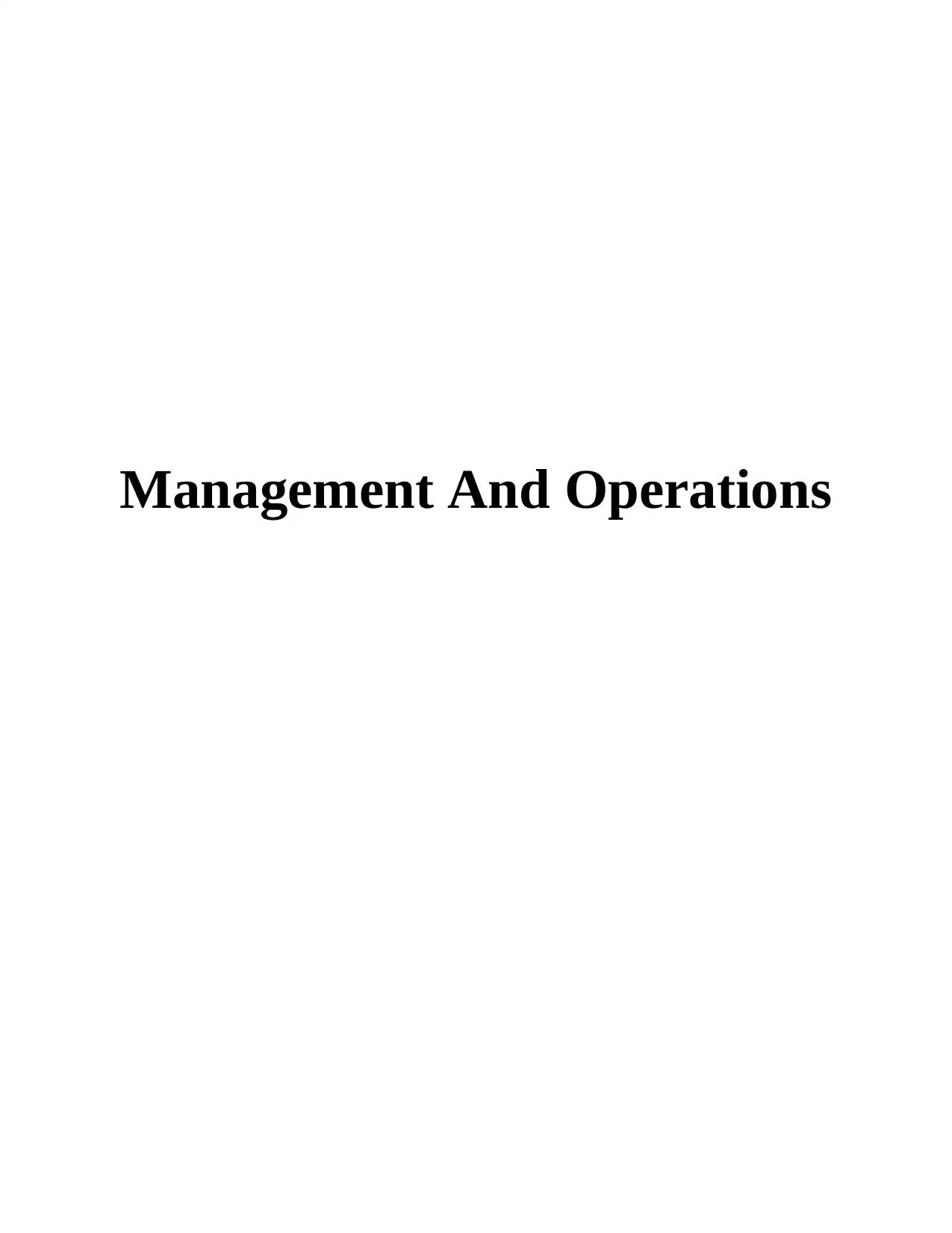
Management And Operations
Paraphrase This Document
Need a fresh take? Get an instant paraphrase of this document with our AI Paraphraser
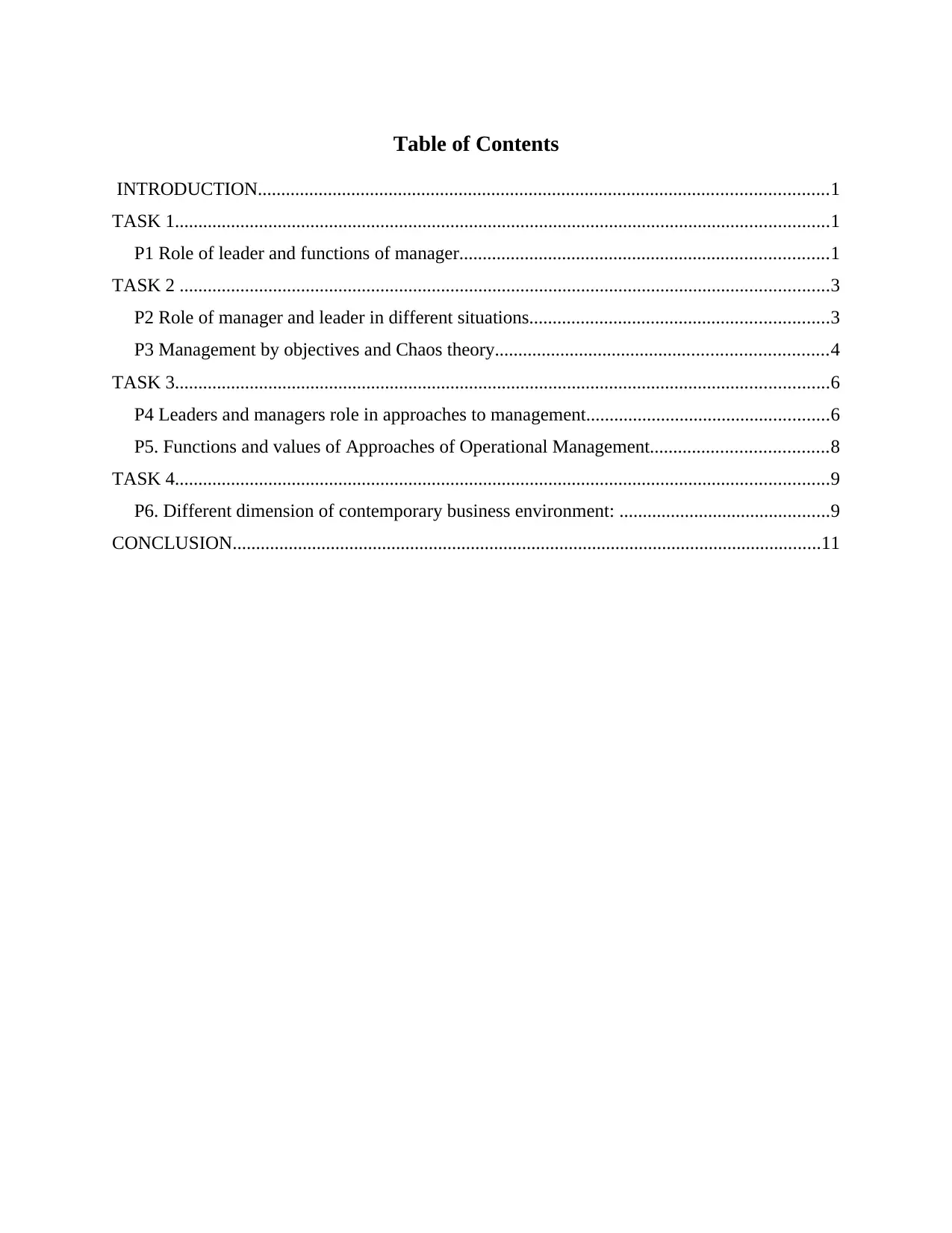
Table of Contents
INTRODUCTION..........................................................................................................................1
TASK 1............................................................................................................................................1
P1 Role of leader and functions of manager...............................................................................1
TASK 2 ...........................................................................................................................................3
P2 Role of manager and leader in different situations................................................................3
P3 Management by objectives and Chaos theory.......................................................................4
TASK 3............................................................................................................................................6
P4 Leaders and managers role in approaches to management....................................................6
P5. Functions and values of Approaches of Operational Management......................................8
TASK 4............................................................................................................................................9
P6. Different dimension of contemporary business environment: .............................................9
CONCLUSION..............................................................................................................................11
INTRODUCTION..........................................................................................................................1
TASK 1............................................................................................................................................1
P1 Role of leader and functions of manager...............................................................................1
TASK 2 ...........................................................................................................................................3
P2 Role of manager and leader in different situations................................................................3
P3 Management by objectives and Chaos theory.......................................................................4
TASK 3............................................................................................................................................6
P4 Leaders and managers role in approaches to management....................................................6
P5. Functions and values of Approaches of Operational Management......................................8
TASK 4............................................................................................................................................9
P6. Different dimension of contemporary business environment: .............................................9
CONCLUSION..............................................................................................................................11
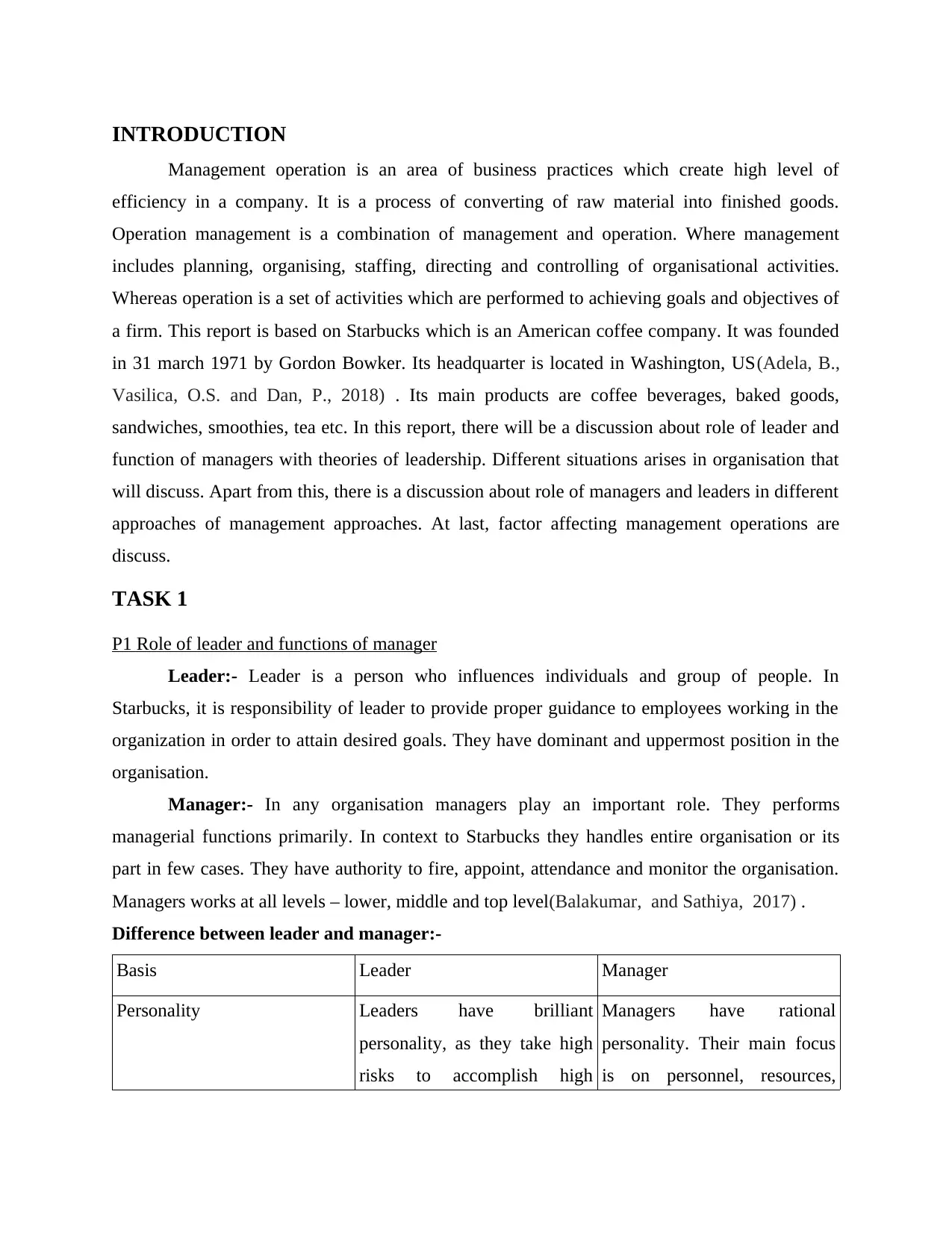
INTRODUCTION
Management operation is an area of business practices which create high level of
efficiency in a company. It is a process of converting of raw material into finished goods.
Operation management is a combination of management and operation. Where management
includes planning, organising, staffing, directing and controlling of organisational activities.
Whereas operation is a set of activities which are performed to achieving goals and objectives of
a firm. This report is based on Starbucks which is an American coffee company. It was founded
in 31 march 1971 by Gordon Bowker. Its headquarter is located in Washington, US(Adela, B.,
Vasilica, O.S. and Dan, P., 2018) . Its main products are coffee beverages, baked goods,
sandwiches, smoothies, tea etc. In this report, there will be a discussion about role of leader and
function of managers with theories of leadership. Different situations arises in organisation that
will discuss. Apart from this, there is a discussion about role of managers and leaders in different
approaches of management approaches. At last, factor affecting management operations are
discuss.
TASK 1
P1 Role of leader and functions of manager
Leader:- Leader is a person who influences individuals and group of people. In
Starbucks, it is responsibility of leader to provide proper guidance to employees working in the
organization in order to attain desired goals. They have dominant and uppermost position in the
organisation.
Manager:- In any organisation managers play an important role. They performs
managerial functions primarily. In context to Starbucks they handles entire organisation or its
part in few cases. They have authority to fire, appoint, attendance and monitor the organisation.
Managers works at all levels – lower, middle and top level(Balakumar, and Sathiya, 2017) .
Difference between leader and manager:-
Basis Leader Manager
Personality Leaders have brilliant
personality, as they take high
risks to accomplish high
Managers have rational
personality. Their main focus
is on personnel, resources,
Management operation is an area of business practices which create high level of
efficiency in a company. It is a process of converting of raw material into finished goods.
Operation management is a combination of management and operation. Where management
includes planning, organising, staffing, directing and controlling of organisational activities.
Whereas operation is a set of activities which are performed to achieving goals and objectives of
a firm. This report is based on Starbucks which is an American coffee company. It was founded
in 31 march 1971 by Gordon Bowker. Its headquarter is located in Washington, US(Adela, B.,
Vasilica, O.S. and Dan, P., 2018) . Its main products are coffee beverages, baked goods,
sandwiches, smoothies, tea etc. In this report, there will be a discussion about role of leader and
function of managers with theories of leadership. Different situations arises in organisation that
will discuss. Apart from this, there is a discussion about role of managers and leaders in different
approaches of management approaches. At last, factor affecting management operations are
discuss.
TASK 1
P1 Role of leader and functions of manager
Leader:- Leader is a person who influences individuals and group of people. In
Starbucks, it is responsibility of leader to provide proper guidance to employees working in the
organization in order to attain desired goals. They have dominant and uppermost position in the
organisation.
Manager:- In any organisation managers play an important role. They performs
managerial functions primarily. In context to Starbucks they handles entire organisation or its
part in few cases. They have authority to fire, appoint, attendance and monitor the organisation.
Managers works at all levels – lower, middle and top level(Balakumar, and Sathiya, 2017) .
Difference between leader and manager:-
Basis Leader Manager
Personality Leaders have brilliant
personality, as they take high
risks to accomplish high
Managers have rational
personality. Their main focus
is on personnel, resources,
⊘ This is a preview!⊘
Do you want full access?
Subscribe today to unlock all pages.

Trusted by 1+ million students worldwide
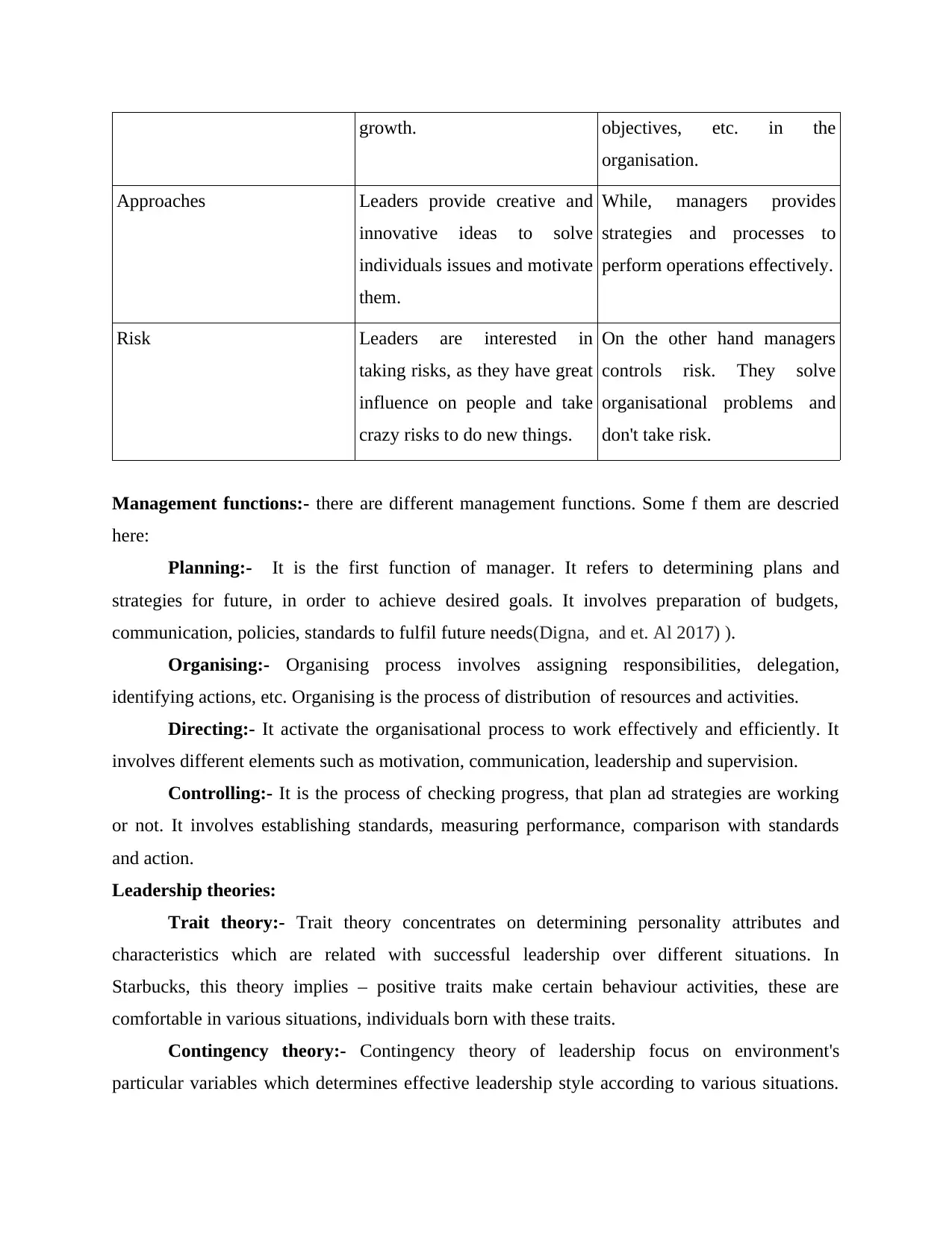
growth. objectives, etc. in the
organisation.
Approaches Leaders provide creative and
innovative ideas to solve
individuals issues and motivate
them.
While, managers provides
strategies and processes to
perform operations effectively.
Risk Leaders are interested in
taking risks, as they have great
influence on people and take
crazy risks to do new things.
On the other hand managers
controls risk. They solve
organisational problems and
don't take risk.
Management functions:- there are different management functions. Some f them are descried
here:
Planning:- It is the first function of manager. It refers to determining plans and
strategies for future, in order to achieve desired goals. It involves preparation of budgets,
communication, policies, standards to fulfil future needs(Digna, and et. Al 2017) ).
Organising:- Organising process involves assigning responsibilities, delegation,
identifying actions, etc. Organising is the process of distribution of resources and activities.
Directing:- It activate the organisational process to work effectively and efficiently. It
involves different elements such as motivation, communication, leadership and supervision.
Controlling:- It is the process of checking progress, that plan ad strategies are working
or not. It involves establishing standards, measuring performance, comparison with standards
and action.
Leadership theories:
Trait theory:- Trait theory concentrates on determining personality attributes and
characteristics which are related with successful leadership over different situations. In
Starbucks, this theory implies – positive traits make certain behaviour activities, these are
comfortable in various situations, individuals born with these traits.
Contingency theory:- Contingency theory of leadership focus on environment's
particular variables which determines effective leadership style according to various situations.
organisation.
Approaches Leaders provide creative and
innovative ideas to solve
individuals issues and motivate
them.
While, managers provides
strategies and processes to
perform operations effectively.
Risk Leaders are interested in
taking risks, as they have great
influence on people and take
crazy risks to do new things.
On the other hand managers
controls risk. They solve
organisational problems and
don't take risk.
Management functions:- there are different management functions. Some f them are descried
here:
Planning:- It is the first function of manager. It refers to determining plans and
strategies for future, in order to achieve desired goals. It involves preparation of budgets,
communication, policies, standards to fulfil future needs(Digna, and et. Al 2017) ).
Organising:- Organising process involves assigning responsibilities, delegation,
identifying actions, etc. Organising is the process of distribution of resources and activities.
Directing:- It activate the organisational process to work effectively and efficiently. It
involves different elements such as motivation, communication, leadership and supervision.
Controlling:- It is the process of checking progress, that plan ad strategies are working
or not. It involves establishing standards, measuring performance, comparison with standards
and action.
Leadership theories:
Trait theory:- Trait theory concentrates on determining personality attributes and
characteristics which are related with successful leadership over different situations. In
Starbucks, this theory implies – positive traits make certain behaviour activities, these are
comfortable in various situations, individuals born with these traits.
Contingency theory:- Contingency theory of leadership focus on environment's
particular variables which determines effective leadership style according to various situations.
Paraphrase This Document
Need a fresh take? Get an instant paraphrase of this document with our AI Paraphraser
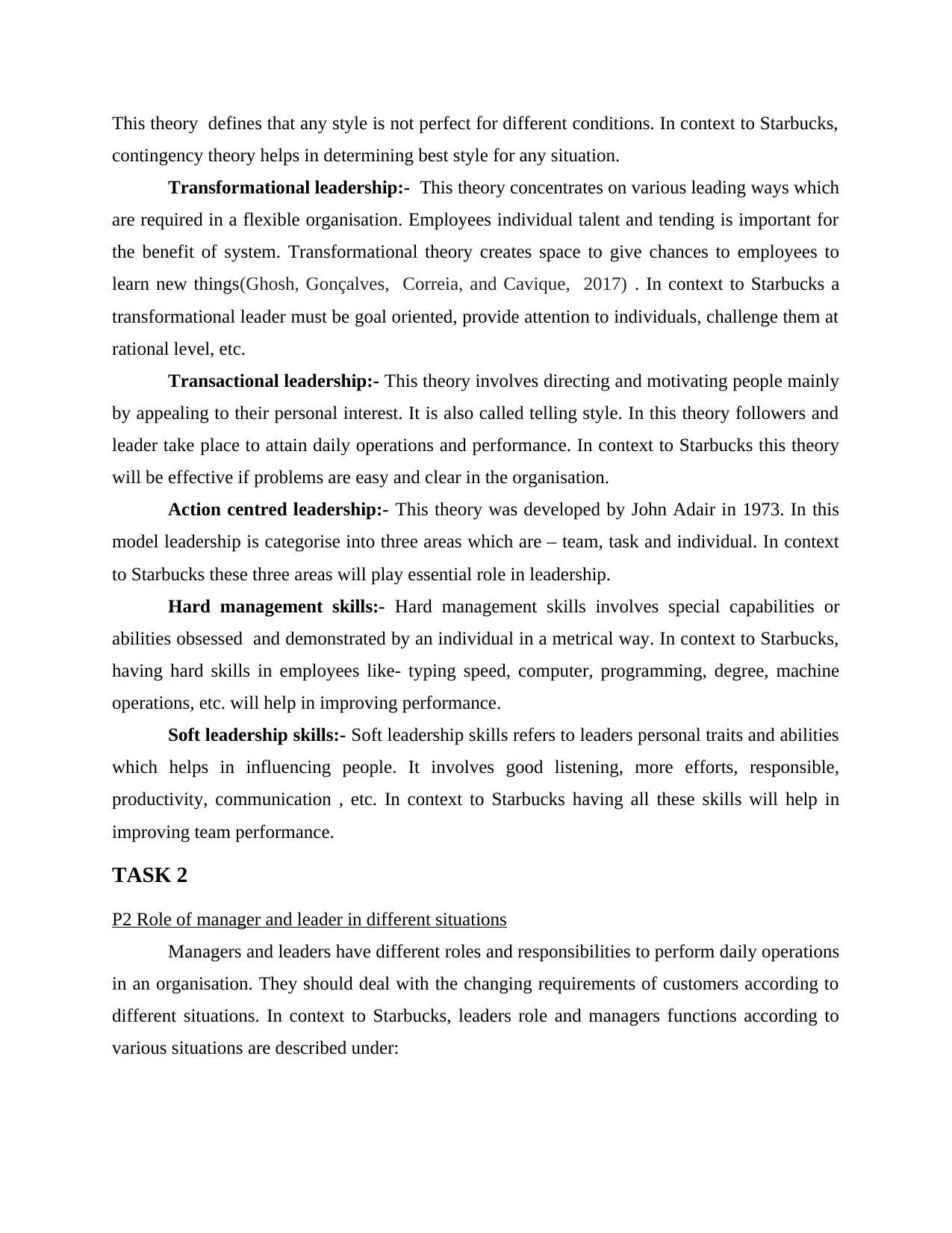
This theory defines that any style is not perfect for different conditions. In context to Starbucks,
contingency theory helps in determining best style for any situation.
Transformational leadership:- This theory concentrates on various leading ways which
are required in a flexible organisation. Employees individual talent and tending is important for
the benefit of system. Transformational theory creates space to give chances to employees to
learn new things(Ghosh, Gonçalves, Correia, and Cavique, 2017) . In context to Starbucks a
transformational leader must be goal oriented, provide attention to individuals, challenge them at
rational level, etc.
Transactional leadership:- This theory involves directing and motivating people mainly
by appealing to their personal interest. It is also called telling style. In this theory followers and
leader take place to attain daily operations and performance. In context to Starbucks this theory
will be effective if problems are easy and clear in the organisation.
Action centred leadership:- This theory was developed by John Adair in 1973. In this
model leadership is categorise into three areas which are – team, task and individual. In context
to Starbucks these three areas will play essential role in leadership.
Hard management skills:- Hard management skills involves special capabilities or
abilities obsessed and demonstrated by an individual in a metrical way. In context to Starbucks,
having hard skills in employees like- typing speed, computer, programming, degree, machine
operations, etc. will help in improving performance.
Soft leadership skills:- Soft leadership skills refers to leaders personal traits and abilities
which helps in influencing people. It involves good listening, more efforts, responsible,
productivity, communication , etc. In context to Starbucks having all these skills will help in
improving team performance.
TASK 2
P2 Role of manager and leader in different situations
Managers and leaders have different roles and responsibilities to perform daily operations
in an organisation. They should deal with the changing requirements of customers according to
different situations. In context to Starbucks, leaders role and managers functions according to
various situations are described under:
contingency theory helps in determining best style for any situation.
Transformational leadership:- This theory concentrates on various leading ways which
are required in a flexible organisation. Employees individual talent and tending is important for
the benefit of system. Transformational theory creates space to give chances to employees to
learn new things(Ghosh, Gonçalves, Correia, and Cavique, 2017) . In context to Starbucks a
transformational leader must be goal oriented, provide attention to individuals, challenge them at
rational level, etc.
Transactional leadership:- This theory involves directing and motivating people mainly
by appealing to their personal interest. It is also called telling style. In this theory followers and
leader take place to attain daily operations and performance. In context to Starbucks this theory
will be effective if problems are easy and clear in the organisation.
Action centred leadership:- This theory was developed by John Adair in 1973. In this
model leadership is categorise into three areas which are – team, task and individual. In context
to Starbucks these three areas will play essential role in leadership.
Hard management skills:- Hard management skills involves special capabilities or
abilities obsessed and demonstrated by an individual in a metrical way. In context to Starbucks,
having hard skills in employees like- typing speed, computer, programming, degree, machine
operations, etc. will help in improving performance.
Soft leadership skills:- Soft leadership skills refers to leaders personal traits and abilities
which helps in influencing people. It involves good listening, more efforts, responsible,
productivity, communication , etc. In context to Starbucks having all these skills will help in
improving team performance.
TASK 2
P2 Role of manager and leader in different situations
Managers and leaders have different roles and responsibilities to perform daily operations
in an organisation. They should deal with the changing requirements of customers according to
different situations. In context to Starbucks, leaders role and managers functions according to
various situations are described under:
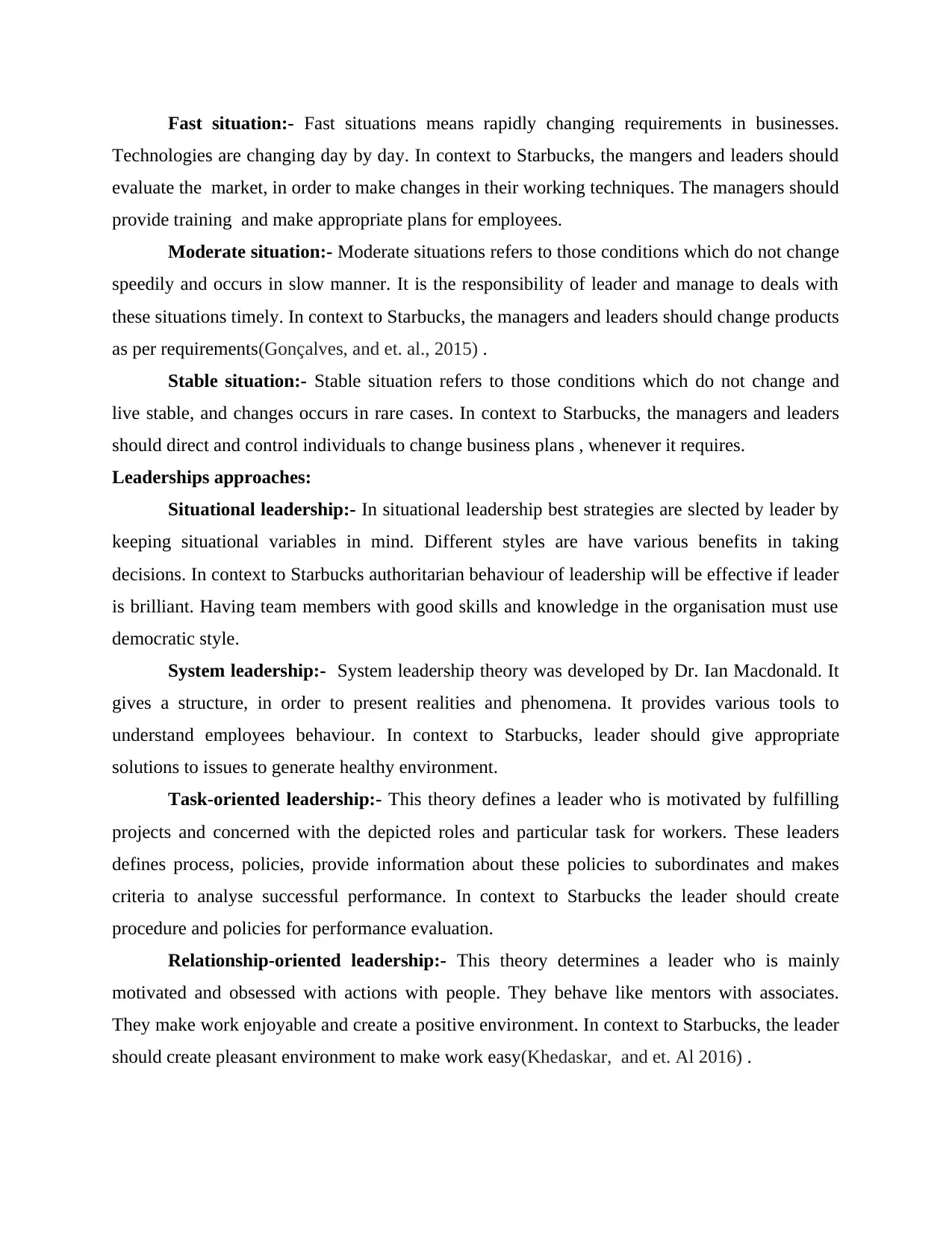
Fast situation:- Fast situations means rapidly changing requirements in businesses.
Technologies are changing day by day. In context to Starbucks, the mangers and leaders should
evaluate the market, in order to make changes in their working techniques. The managers should
provide training and make appropriate plans for employees.
Moderate situation:- Moderate situations refers to those conditions which do not change
speedily and occurs in slow manner. It is the responsibility of leader and manage to deals with
these situations timely. In context to Starbucks, the managers and leaders should change products
as per requirements(Gonçalves, and et. al., 2015) .
Stable situation:- Stable situation refers to those conditions which do not change and
live stable, and changes occurs in rare cases. In context to Starbucks, the managers and leaders
should direct and control individuals to change business plans , whenever it requires.
Leaderships approaches:
Situational leadership:- In situational leadership best strategies are slected by leader by
keeping situational variables in mind. Different styles are have various benefits in taking
decisions. In context to Starbucks authoritarian behaviour of leadership will be effective if leader
is brilliant. Having team members with good skills and knowledge in the organisation must use
democratic style.
System leadership:- System leadership theory was developed by Dr. Ian Macdonald. It
gives a structure, in order to present realities and phenomena. It provides various tools to
understand employees behaviour. In context to Starbucks, leader should give appropriate
solutions to issues to generate healthy environment.
Task-oriented leadership:- This theory defines a leader who is motivated by fulfilling
projects and concerned with the depicted roles and particular task for workers. These leaders
defines process, policies, provide information about these policies to subordinates and makes
criteria to analyse successful performance. In context to Starbucks the leader should create
procedure and policies for performance evaluation.
Relationship-oriented leadership:- This theory determines a leader who is mainly
motivated and obsessed with actions with people. They behave like mentors with associates.
They make work enjoyable and create a positive environment. In context to Starbucks, the leader
should create pleasant environment to make work easy(Khedaskar, and et. Al 2016) .
Technologies are changing day by day. In context to Starbucks, the mangers and leaders should
evaluate the market, in order to make changes in their working techniques. The managers should
provide training and make appropriate plans for employees.
Moderate situation:- Moderate situations refers to those conditions which do not change
speedily and occurs in slow manner. It is the responsibility of leader and manage to deals with
these situations timely. In context to Starbucks, the managers and leaders should change products
as per requirements(Gonçalves, and et. al., 2015) .
Stable situation:- Stable situation refers to those conditions which do not change and
live stable, and changes occurs in rare cases. In context to Starbucks, the managers and leaders
should direct and control individuals to change business plans , whenever it requires.
Leaderships approaches:
Situational leadership:- In situational leadership best strategies are slected by leader by
keeping situational variables in mind. Different styles are have various benefits in taking
decisions. In context to Starbucks authoritarian behaviour of leadership will be effective if leader
is brilliant. Having team members with good skills and knowledge in the organisation must use
democratic style.
System leadership:- System leadership theory was developed by Dr. Ian Macdonald. It
gives a structure, in order to present realities and phenomena. It provides various tools to
understand employees behaviour. In context to Starbucks, leader should give appropriate
solutions to issues to generate healthy environment.
Task-oriented leadership:- This theory defines a leader who is motivated by fulfilling
projects and concerned with the depicted roles and particular task for workers. These leaders
defines process, policies, provide information about these policies to subordinates and makes
criteria to analyse successful performance. In context to Starbucks the leader should create
procedure and policies for performance evaluation.
Relationship-oriented leadership:- This theory determines a leader who is mainly
motivated and obsessed with actions with people. They behave like mentors with associates.
They make work enjoyable and create a positive environment. In context to Starbucks, the leader
should create pleasant environment to make work easy(Khedaskar, and et. Al 2016) .
⊘ This is a preview!⊘
Do you want full access?
Subscribe today to unlock all pages.

Trusted by 1+ million students worldwide
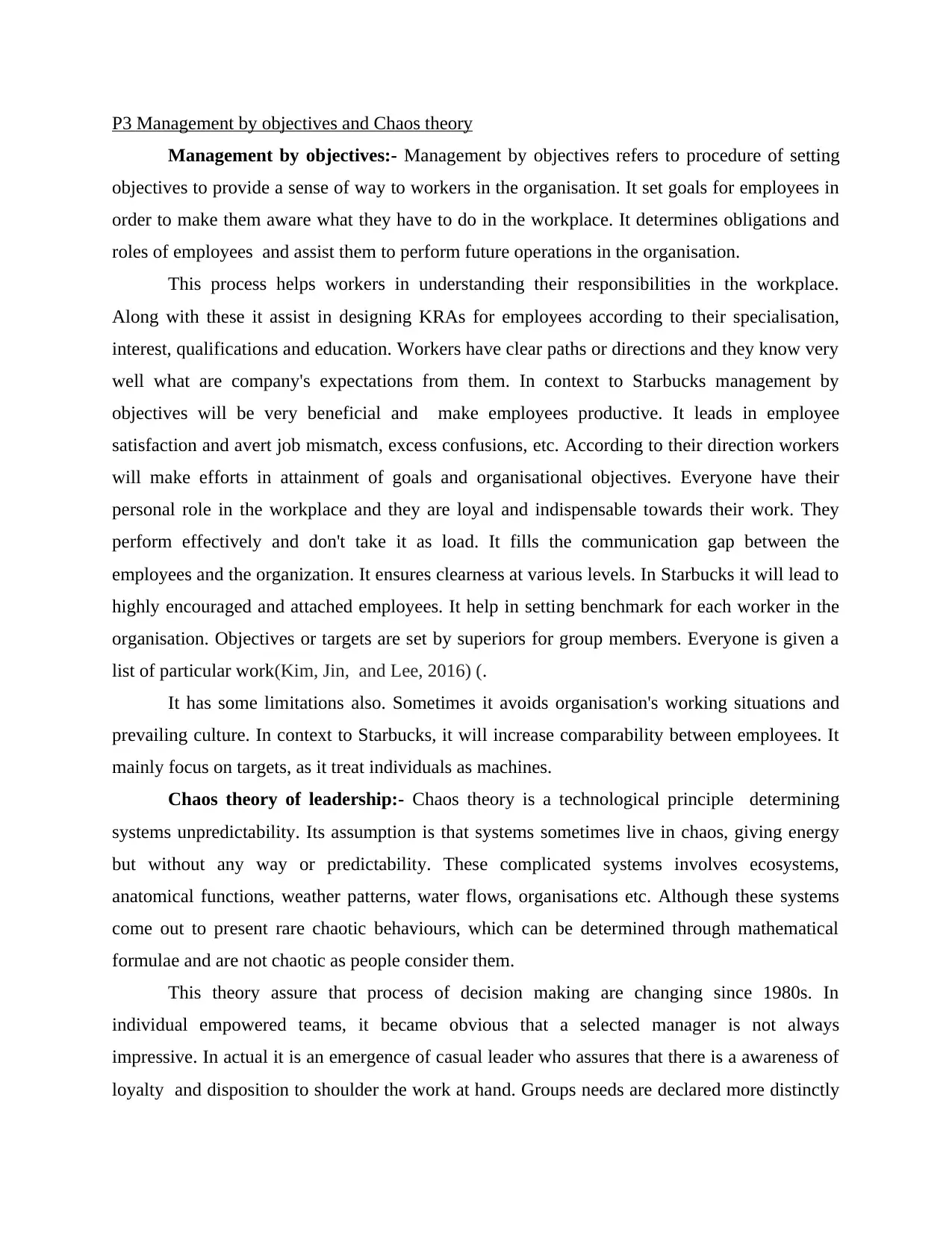
P3 Management by objectives and Chaos theory
Management by objectives:- Management by objectives refers to procedure of setting
objectives to provide a sense of way to workers in the organisation. It set goals for employees in
order to make them aware what they have to do in the workplace. It determines obligations and
roles of employees and assist them to perform future operations in the organisation.
This process helps workers in understanding their responsibilities in the workplace.
Along with these it assist in designing KRAs for employees according to their specialisation,
interest, qualifications and education. Workers have clear paths or directions and they know very
well what are company's expectations from them. In context to Starbucks management by
objectives will be very beneficial and make employees productive. It leads in employee
satisfaction and avert job mismatch, excess confusions, etc. According to their direction workers
will make efforts in attainment of goals and organisational objectives. Everyone have their
personal role in the workplace and they are loyal and indispensable towards their work. They
perform effectively and don't take it as load. It fills the communication gap between the
employees and the organization. It ensures clearness at various levels. In Starbucks it will lead to
highly encouraged and attached employees. It help in setting benchmark for each worker in the
organisation. Objectives or targets are set by superiors for group members. Everyone is given a
list of particular work(Kim, Jin, and Lee, 2016) (.
It has some limitations also. Sometimes it avoids organisation's working situations and
prevailing culture. In context to Starbucks, it will increase comparability between employees. It
mainly focus on targets, as it treat individuals as machines.
Chaos theory of leadership:- Chaos theory is a technological principle determining
systems unpredictability. Its assumption is that systems sometimes live in chaos, giving energy
but without any way or predictability. These complicated systems involves ecosystems,
anatomical functions, weather patterns, water flows, organisations etc. Although these systems
come out to present rare chaotic behaviours, which can be determined through mathematical
formulae and are not chaotic as people consider them.
This theory assure that process of decision making are changing since 1980s. In
individual empowered teams, it became obvious that a selected manager is not always
impressive. In actual it is an emergence of casual leader who assures that there is a awareness of
loyalty and disposition to shoulder the work at hand. Groups needs are declared more distinctly
Management by objectives:- Management by objectives refers to procedure of setting
objectives to provide a sense of way to workers in the organisation. It set goals for employees in
order to make them aware what they have to do in the workplace. It determines obligations and
roles of employees and assist them to perform future operations in the organisation.
This process helps workers in understanding their responsibilities in the workplace.
Along with these it assist in designing KRAs for employees according to their specialisation,
interest, qualifications and education. Workers have clear paths or directions and they know very
well what are company's expectations from them. In context to Starbucks management by
objectives will be very beneficial and make employees productive. It leads in employee
satisfaction and avert job mismatch, excess confusions, etc. According to their direction workers
will make efforts in attainment of goals and organisational objectives. Everyone have their
personal role in the workplace and they are loyal and indispensable towards their work. They
perform effectively and don't take it as load. It fills the communication gap between the
employees and the organization. It ensures clearness at various levels. In Starbucks it will lead to
highly encouraged and attached employees. It help in setting benchmark for each worker in the
organisation. Objectives or targets are set by superiors for group members. Everyone is given a
list of particular work(Kim, Jin, and Lee, 2016) (.
It has some limitations also. Sometimes it avoids organisation's working situations and
prevailing culture. In context to Starbucks, it will increase comparability between employees. It
mainly focus on targets, as it treat individuals as machines.
Chaos theory of leadership:- Chaos theory is a technological principle determining
systems unpredictability. Its assumption is that systems sometimes live in chaos, giving energy
but without any way or predictability. These complicated systems involves ecosystems,
anatomical functions, weather patterns, water flows, organisations etc. Although these systems
come out to present rare chaotic behaviours, which can be determined through mathematical
formulae and are not chaotic as people consider them.
This theory assure that process of decision making are changing since 1980s. In
individual empowered teams, it became obvious that a selected manager is not always
impressive. In actual it is an emergence of casual leader who assures that there is a awareness of
loyalty and disposition to shoulder the work at hand. Groups needs are declared more distinctly
Paraphrase This Document
Need a fresh take? Get an instant paraphrase of this document with our AI Paraphraser
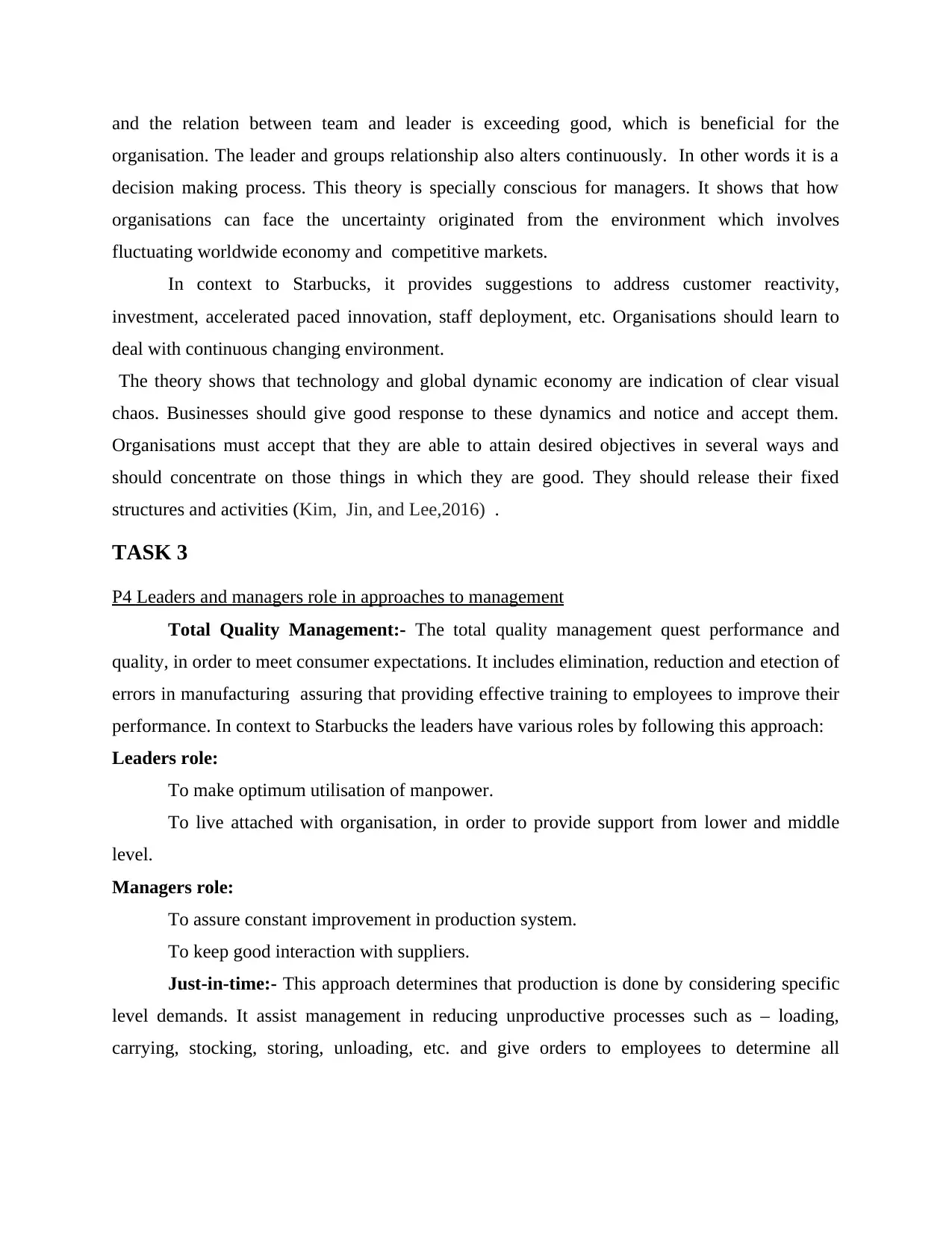
and the relation between team and leader is exceeding good, which is beneficial for the
organisation. The leader and groups relationship also alters continuously. In other words it is a
decision making process. This theory is specially conscious for managers. It shows that how
organisations can face the uncertainty originated from the environment which involves
fluctuating worldwide economy and competitive markets.
In context to Starbucks, it provides suggestions to address customer reactivity,
investment, accelerated paced innovation, staff deployment, etc. Organisations should learn to
deal with continuous changing environment.
The theory shows that technology and global dynamic economy are indication of clear visual
chaos. Businesses should give good response to these dynamics and notice and accept them.
Organisations must accept that they are able to attain desired objectives in several ways and
should concentrate on those things in which they are good. They should release their fixed
structures and activities (Kim, Jin, and Lee,2016) .
TASK 3
P4 Leaders and managers role in approaches to management
Total Quality Management:- The total quality management quest performance and
quality, in order to meet consumer expectations. It includes elimination, reduction and etection of
errors in manufacturing assuring that providing effective training to employees to improve their
performance. In context to Starbucks the leaders have various roles by following this approach:
Leaders role:
To make optimum utilisation of manpower.
To live attached with organisation, in order to provide support from lower and middle
level.
Managers role:
To assure constant improvement in production system.
To keep good interaction with suppliers.
Just-in-time:- This approach determines that production is done by considering specific
level demands. It assist management in reducing unproductive processes such as – loading,
carrying, stocking, storing, unloading, etc. and give orders to employees to determine all
organisation. The leader and groups relationship also alters continuously. In other words it is a
decision making process. This theory is specially conscious for managers. It shows that how
organisations can face the uncertainty originated from the environment which involves
fluctuating worldwide economy and competitive markets.
In context to Starbucks, it provides suggestions to address customer reactivity,
investment, accelerated paced innovation, staff deployment, etc. Organisations should learn to
deal with continuous changing environment.
The theory shows that technology and global dynamic economy are indication of clear visual
chaos. Businesses should give good response to these dynamics and notice and accept them.
Organisations must accept that they are able to attain desired objectives in several ways and
should concentrate on those things in which they are good. They should release their fixed
structures and activities (Kim, Jin, and Lee,2016) .
TASK 3
P4 Leaders and managers role in approaches to management
Total Quality Management:- The total quality management quest performance and
quality, in order to meet consumer expectations. It includes elimination, reduction and etection of
errors in manufacturing assuring that providing effective training to employees to improve their
performance. In context to Starbucks the leaders have various roles by following this approach:
Leaders role:
To make optimum utilisation of manpower.
To live attached with organisation, in order to provide support from lower and middle
level.
Managers role:
To assure constant improvement in production system.
To keep good interaction with suppliers.
Just-in-time:- This approach determines that production is done by considering specific
level demands. It assist management in reducing unproductive processes such as – loading,
carrying, stocking, storing, unloading, etc. and give orders to employees to determine all
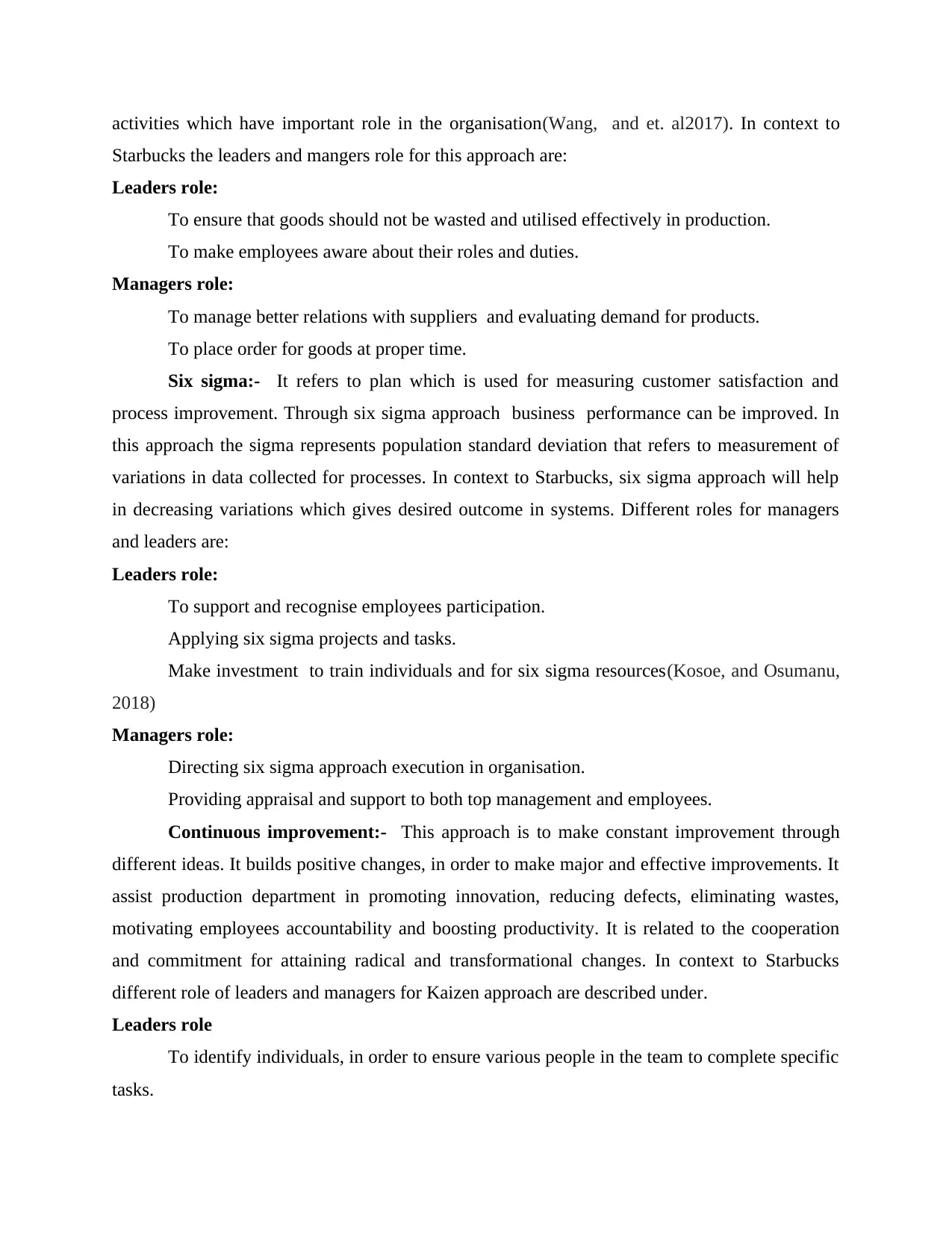
activities which have important role in the organisation(Wang, and et. al2017). In context to
Starbucks the leaders and mangers role for this approach are:
Leaders role:
To ensure that goods should not be wasted and utilised effectively in production.
To make employees aware about their roles and duties.
Managers role:
To manage better relations with suppliers and evaluating demand for products.
To place order for goods at proper time.
Six sigma:- It refers to plan which is used for measuring customer satisfaction and
process improvement. Through six sigma approach business performance can be improved. In
this approach the sigma represents population standard deviation that refers to measurement of
variations in data collected for processes. In context to Starbucks, six sigma approach will help
in decreasing variations which gives desired outcome in systems. Different roles for managers
and leaders are:
Leaders role:
To support and recognise employees participation.
Applying six sigma projects and tasks.
Make investment to train individuals and for six sigma resources(Kosoe, and Osumanu,
2018)
Managers role:
Directing six sigma approach execution in organisation.
Providing appraisal and support to both top management and employees.
Continuous improvement:- This approach is to make constant improvement through
different ideas. It builds positive changes, in order to make major and effective improvements. It
assist production department in promoting innovation, reducing defects, eliminating wastes,
motivating employees accountability and boosting productivity. It is related to the cooperation
and commitment for attaining radical and transformational changes. In context to Starbucks
different role of leaders and managers for Kaizen approach are described under.
Leaders role
To identify individuals, in order to ensure various people in the team to complete specific
tasks.
Starbucks the leaders and mangers role for this approach are:
Leaders role:
To ensure that goods should not be wasted and utilised effectively in production.
To make employees aware about their roles and duties.
Managers role:
To manage better relations with suppliers and evaluating demand for products.
To place order for goods at proper time.
Six sigma:- It refers to plan which is used for measuring customer satisfaction and
process improvement. Through six sigma approach business performance can be improved. In
this approach the sigma represents population standard deviation that refers to measurement of
variations in data collected for processes. In context to Starbucks, six sigma approach will help
in decreasing variations which gives desired outcome in systems. Different roles for managers
and leaders are:
Leaders role:
To support and recognise employees participation.
Applying six sigma projects and tasks.
Make investment to train individuals and for six sigma resources(Kosoe, and Osumanu,
2018)
Managers role:
Directing six sigma approach execution in organisation.
Providing appraisal and support to both top management and employees.
Continuous improvement:- This approach is to make constant improvement through
different ideas. It builds positive changes, in order to make major and effective improvements. It
assist production department in promoting innovation, reducing defects, eliminating wastes,
motivating employees accountability and boosting productivity. It is related to the cooperation
and commitment for attaining radical and transformational changes. In context to Starbucks
different role of leaders and managers for Kaizen approach are described under.
Leaders role
To identify individuals, in order to ensure various people in the team to complete specific
tasks.
⊘ This is a preview!⊘
Do you want full access?
Subscribe today to unlock all pages.

Trusted by 1+ million students worldwide
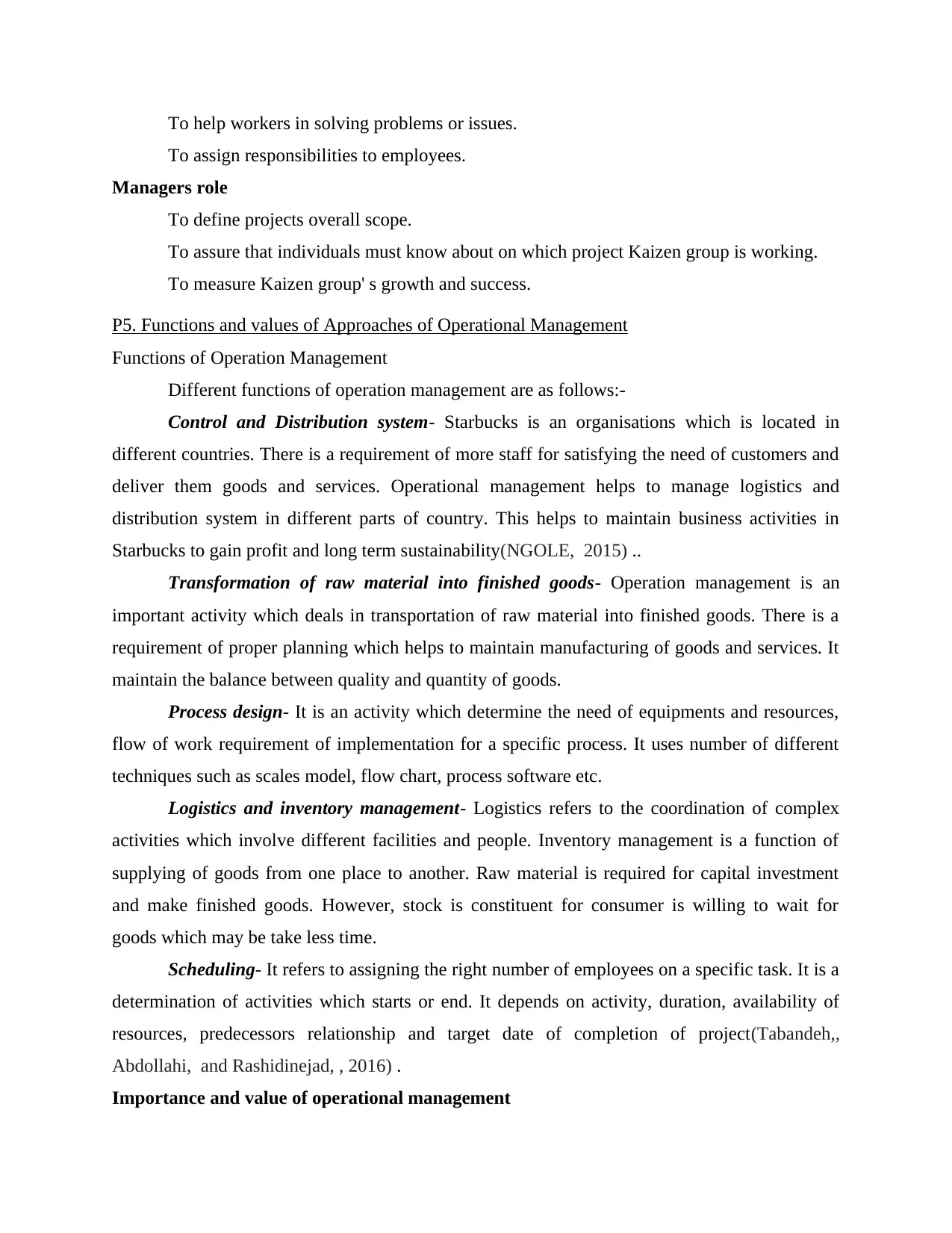
To help workers in solving problems or issues.
To assign responsibilities to employees.
Managers role
To define projects overall scope.
To assure that individuals must know about on which project Kaizen group is working.
To measure Kaizen group' s growth and success.
P5. Functions and values of Approaches of Operational Management
Functions of Operation Management
Different functions of operation management are as follows:-
Control and Distribution system- Starbucks is an organisations which is located in
different countries. There is a requirement of more staff for satisfying the need of customers and
deliver them goods and services. Operational management helps to manage logistics and
distribution system in different parts of country. This helps to maintain business activities in
Starbucks to gain profit and long term sustainability(NGOLE, 2015) ..
Transformation of raw material into finished goods- Operation management is an
important activity which deals in transportation of raw material into finished goods. There is a
requirement of proper planning which helps to maintain manufacturing of goods and services. It
maintain the balance between quality and quantity of goods.
Process design- It is an activity which determine the need of equipments and resources,
flow of work requirement of implementation for a specific process. It uses number of different
techniques such as scales model, flow chart, process software etc.
Logistics and inventory management- Logistics refers to the coordination of complex
activities which involve different facilities and people. Inventory management is a function of
supplying of goods from one place to another. Raw material is required for capital investment
and make finished goods. However, stock is constituent for consumer is willing to wait for
goods which may be take less time.
Scheduling- It refers to assigning the right number of employees on a specific task. It is a
determination of activities which starts or end. It depends on activity, duration, availability of
resources, predecessors relationship and target date of completion of project(Tabandeh,,
Abdollahi, and Rashidinejad, , 2016) .
Importance and value of operational management
To assign responsibilities to employees.
Managers role
To define projects overall scope.
To assure that individuals must know about on which project Kaizen group is working.
To measure Kaizen group' s growth and success.
P5. Functions and values of Approaches of Operational Management
Functions of Operation Management
Different functions of operation management are as follows:-
Control and Distribution system- Starbucks is an organisations which is located in
different countries. There is a requirement of more staff for satisfying the need of customers and
deliver them goods and services. Operational management helps to manage logistics and
distribution system in different parts of country. This helps to maintain business activities in
Starbucks to gain profit and long term sustainability(NGOLE, 2015) ..
Transformation of raw material into finished goods- Operation management is an
important activity which deals in transportation of raw material into finished goods. There is a
requirement of proper planning which helps to maintain manufacturing of goods and services. It
maintain the balance between quality and quantity of goods.
Process design- It is an activity which determine the need of equipments and resources,
flow of work requirement of implementation for a specific process. It uses number of different
techniques such as scales model, flow chart, process software etc.
Logistics and inventory management- Logistics refers to the coordination of complex
activities which involve different facilities and people. Inventory management is a function of
supplying of goods from one place to another. Raw material is required for capital investment
and make finished goods. However, stock is constituent for consumer is willing to wait for
goods which may be take less time.
Scheduling- It refers to assigning the right number of employees on a specific task. It is a
determination of activities which starts or end. It depends on activity, duration, availability of
resources, predecessors relationship and target date of completion of project(Tabandeh,,
Abdollahi, and Rashidinejad, , 2016) .
Importance and value of operational management
Paraphrase This Document
Need a fresh take? Get an instant paraphrase of this document with our AI Paraphraser
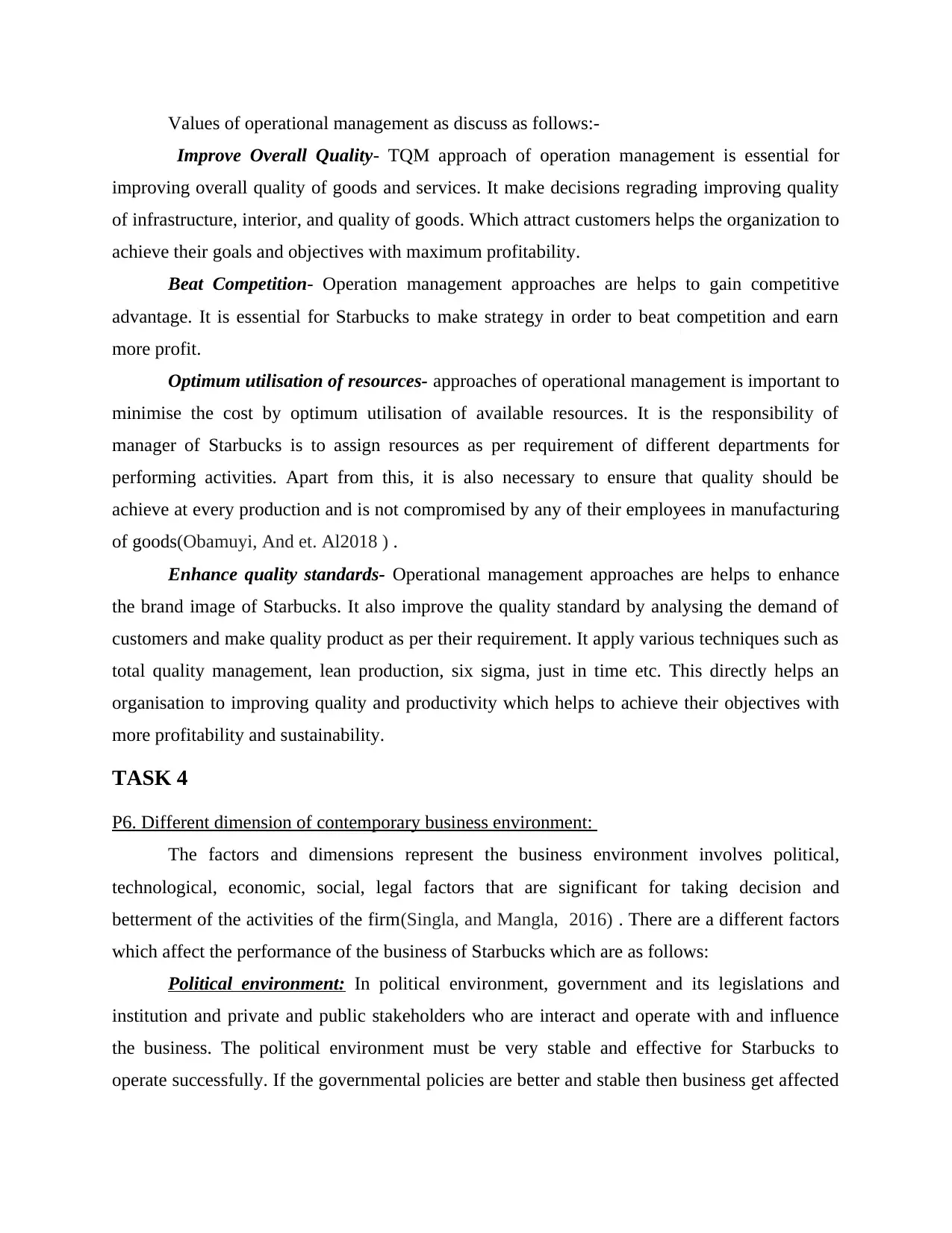
Values of operational management as discuss as follows:-
Improve Overall Quality- TQM approach of operation management is essential for
improving overall quality of goods and services. It make decisions regrading improving quality
of infrastructure, interior, and quality of goods. Which attract customers helps the organization to
achieve their goals and objectives with maximum profitability.
Beat Competition- Operation management approaches are helps to gain competitive
advantage. It is essential for Starbucks to make strategy in order to beat competition and earn
more profit.
Optimum utilisation of resources- approaches of operational management is important to
minimise the cost by optimum utilisation of available resources. It is the responsibility of
manager of Starbucks is to assign resources as per requirement of different departments for
performing activities. Apart from this, it is also necessary to ensure that quality should be
achieve at every production and is not compromised by any of their employees in manufacturing
of goods(Obamuyi, And et. Al2018 ) .
Enhance quality standards- Operational management approaches are helps to enhance
the brand image of Starbucks. It also improve the quality standard by analysing the demand of
customers and make quality product as per their requirement. It apply various techniques such as
total quality management, lean production, six sigma, just in time etc. This directly helps an
organisation to improving quality and productivity which helps to achieve their objectives with
more profitability and sustainability.
TASK 4
P6. Different dimension of contemporary business environment:
The factors and dimensions represent the business environment involves political,
technological, economic, social, legal factors that are significant for taking decision and
betterment of the activities of the firm(Singla, and Mangla, 2016) . There are a different factors
which affect the performance of the business of Starbucks which are as follows:
Political environment: In political environment, government and its legislations and
institution and private and public stakeholders who are interact and operate with and influence
the business. The political environment must be very stable and effective for Starbucks to
operate successfully. If the governmental policies are better and stable then business get affected
Improve Overall Quality- TQM approach of operation management is essential for
improving overall quality of goods and services. It make decisions regrading improving quality
of infrastructure, interior, and quality of goods. Which attract customers helps the organization to
achieve their goals and objectives with maximum profitability.
Beat Competition- Operation management approaches are helps to gain competitive
advantage. It is essential for Starbucks to make strategy in order to beat competition and earn
more profit.
Optimum utilisation of resources- approaches of operational management is important to
minimise the cost by optimum utilisation of available resources. It is the responsibility of
manager of Starbucks is to assign resources as per requirement of different departments for
performing activities. Apart from this, it is also necessary to ensure that quality should be
achieve at every production and is not compromised by any of their employees in manufacturing
of goods(Obamuyi, And et. Al2018 ) .
Enhance quality standards- Operational management approaches are helps to enhance
the brand image of Starbucks. It also improve the quality standard by analysing the demand of
customers and make quality product as per their requirement. It apply various techniques such as
total quality management, lean production, six sigma, just in time etc. This directly helps an
organisation to improving quality and productivity which helps to achieve their objectives with
more profitability and sustainability.
TASK 4
P6. Different dimension of contemporary business environment:
The factors and dimensions represent the business environment involves political,
technological, economic, social, legal factors that are significant for taking decision and
betterment of the activities of the firm(Singla, and Mangla, 2016) . There are a different factors
which affect the performance of the business of Starbucks which are as follows:
Political environment: In political environment, government and its legislations and
institution and private and public stakeholders who are interact and operate with and influence
the business. The political environment must be very stable and effective for Starbucks to
operate successfully. If the governmental policies are better and stable then business get affected
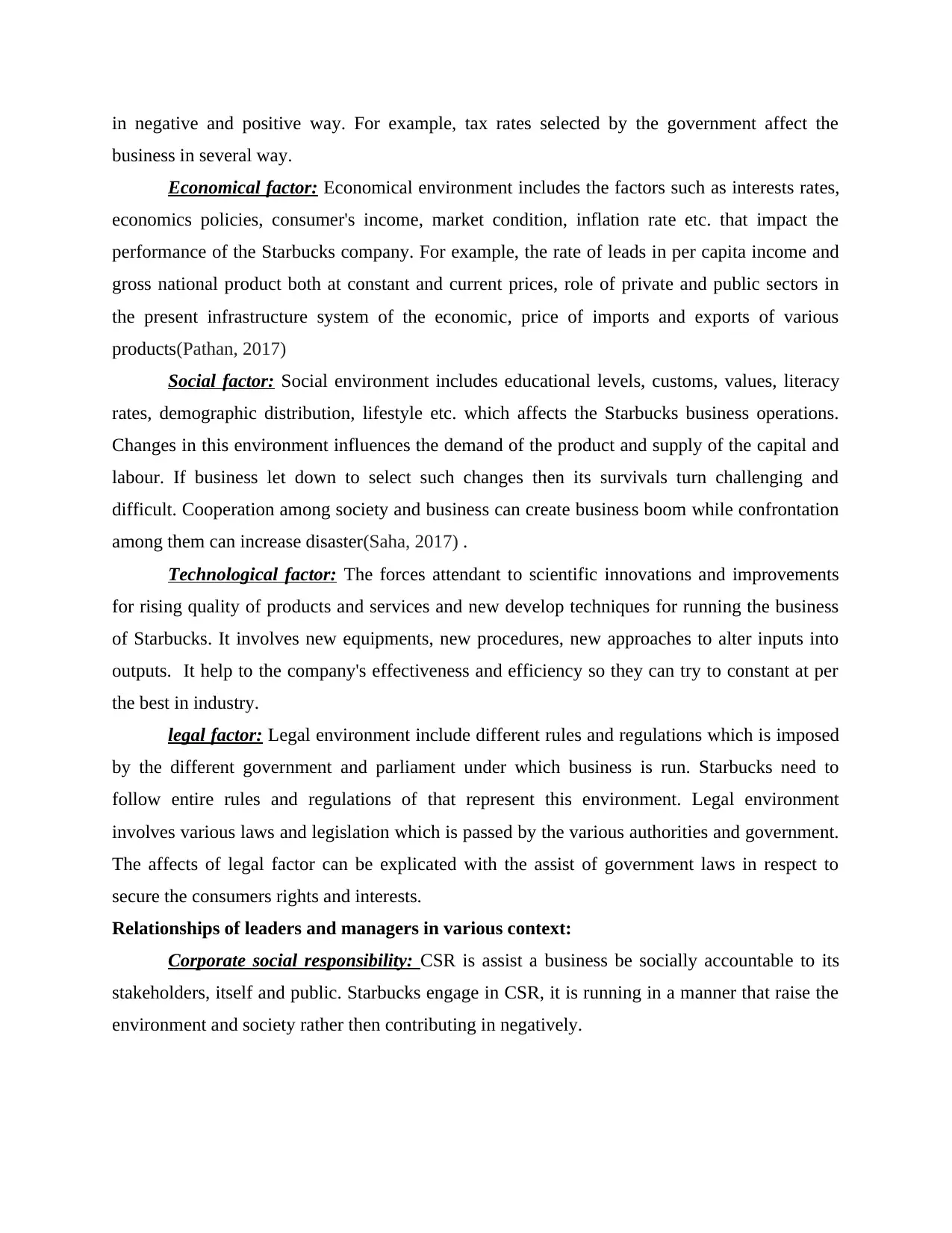
in negative and positive way. For example, tax rates selected by the government affect the
business in several way.
Economical factor: Economical environment includes the factors such as interests rates,
economics policies, consumer's income, market condition, inflation rate etc. that impact the
performance of the Starbucks company. For example, the rate of leads in per capita income and
gross national product both at constant and current prices, role of private and public sectors in
the present infrastructure system of the economic, price of imports and exports of various
products(Pathan, 2017)
Social factor: Social environment includes educational levels, customs, values, literacy
rates, demographic distribution, lifestyle etc. which affects the Starbucks business operations.
Changes in this environment influences the demand of the product and supply of the capital and
labour. If business let down to select such changes then its survivals turn challenging and
difficult. Cooperation among society and business can create business boom while confrontation
among them can increase disaster(Saha, 2017) .
Technological factor: The forces attendant to scientific innovations and improvements
for rising quality of products and services and new develop techniques for running the business
of Starbucks. It involves new equipments, new procedures, new approaches to alter inputs into
outputs. It help to the company's effectiveness and efficiency so they can try to constant at per
the best in industry.
legal factor: Legal environment include different rules and regulations which is imposed
by the different government and parliament under which business is run. Starbucks need to
follow entire rules and regulations of that represent this environment. Legal environment
involves various laws and legislation which is passed by the various authorities and government.
The affects of legal factor can be explicated with the assist of government laws in respect to
secure the consumers rights and interests.
Relationships of leaders and managers in various context:
Corporate social responsibility: CSR is assist a business be socially accountable to its
stakeholders, itself and public. Starbucks engage in CSR, it is running in a manner that raise the
environment and society rather then contributing in negatively.
business in several way.
Economical factor: Economical environment includes the factors such as interests rates,
economics policies, consumer's income, market condition, inflation rate etc. that impact the
performance of the Starbucks company. For example, the rate of leads in per capita income and
gross national product both at constant and current prices, role of private and public sectors in
the present infrastructure system of the economic, price of imports and exports of various
products(Pathan, 2017)
Social factor: Social environment includes educational levels, customs, values, literacy
rates, demographic distribution, lifestyle etc. which affects the Starbucks business operations.
Changes in this environment influences the demand of the product and supply of the capital and
labour. If business let down to select such changes then its survivals turn challenging and
difficult. Cooperation among society and business can create business boom while confrontation
among them can increase disaster(Saha, 2017) .
Technological factor: The forces attendant to scientific innovations and improvements
for rising quality of products and services and new develop techniques for running the business
of Starbucks. It involves new equipments, new procedures, new approaches to alter inputs into
outputs. It help to the company's effectiveness and efficiency so they can try to constant at per
the best in industry.
legal factor: Legal environment include different rules and regulations which is imposed
by the different government and parliament under which business is run. Starbucks need to
follow entire rules and regulations of that represent this environment. Legal environment
involves various laws and legislation which is passed by the various authorities and government.
The affects of legal factor can be explicated with the assist of government laws in respect to
secure the consumers rights and interests.
Relationships of leaders and managers in various context:
Corporate social responsibility: CSR is assist a business be socially accountable to its
stakeholders, itself and public. Starbucks engage in CSR, it is running in a manner that raise the
environment and society rather then contributing in negatively.
⊘ This is a preview!⊘
Do you want full access?
Subscribe today to unlock all pages.

Trusted by 1+ million students worldwide
1 out of 15
Related Documents
Your All-in-One AI-Powered Toolkit for Academic Success.
+13062052269
info@desklib.com
Available 24*7 on WhatsApp / Email
![[object Object]](/_next/static/media/star-bottom.7253800d.svg)
Unlock your academic potential
Copyright © 2020–2025 A2Z Services. All Rights Reserved. Developed and managed by ZUCOL.





